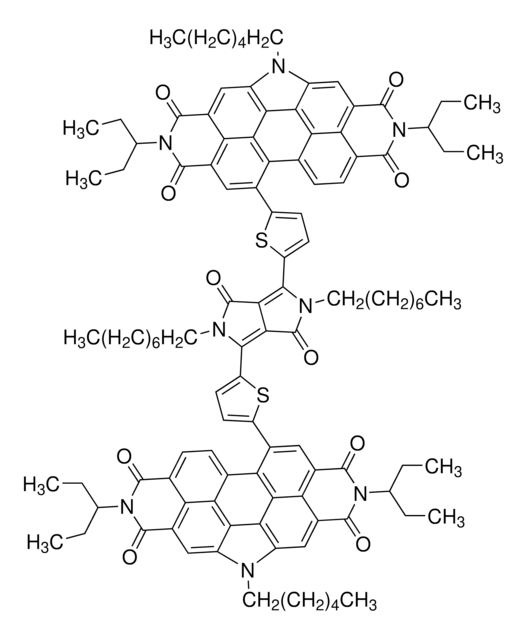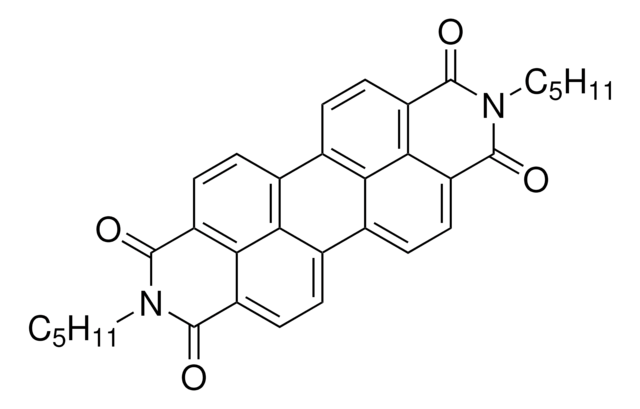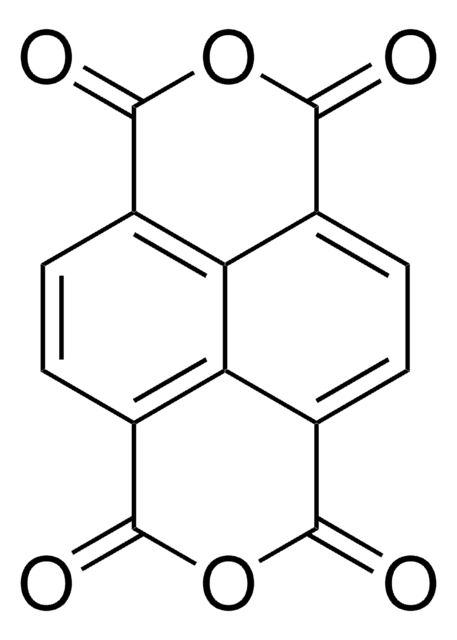932353
PTCDI
Synonym(s):
3,4,9,10-Perylenetetracarboxylic acid diimide
Sign Into View Organizational & Contract Pricing
All Photos(2)
About This Item
Empirical Formula (Hill Notation):
C24H10N2O4
CAS Number:
Molecular Weight:
390.35
MDL number:
UNSPSC Code:
12352302
NACRES:
NA.23
Recommended Products
Related Categories
Application
This TADF emitter is a sublimed high purity material, solution processable 3,4,9,10-perylenetetracarboxylic diimide has been reported for use in:
- photovoltaics
- thermoelectricity (induced by the Soret effect )
- batteries for energy storage
- photocatalysis for water purification or selective solar fuel production from CO2
- chemosensing
Signal Word
Warning
Hazard Statements
Precautionary Statements
Hazard Classifications
STOT RE 2
Storage Class Code
11 - Combustible Solids
WGK
WGK 3
Flash Point(F)
Not applicable
Flash Point(C)
Not applicable
Certificates of Analysis (COA)
Search for Certificates of Analysis (COA) by entering the products Lot/Batch Number. Lot and Batch Numbers can be found on a product’s label following the words ‘Lot’ or ‘Batch’.
Already Own This Product?
Find documentation for the products that you have recently purchased in the Document Library.
Shu Wang et al.
ACS nano, 14(5), 5998-6006 (2020-05-10)
The visual aesthetic that involves color, brightness, and glossiness is of great importance for building integrated photovoltaics. Semitransparent organic solar cells (ST-OSCs) are thus considered as the most promising candidate due to their superiority in transparency and efficiency. However, the
Di Liu et al.
Advanced materials (Deerfield Beach, Fla.), 28(33), 7284-7290 (2016-06-17)
A self-assembled perylene-3,4,9,10-tetracarboxylic diimide(PDINH) supramolecular system consisting of all-organic PDINH molecule building blocks through non-covalent interactions works as a visible light photocatalyst with high activity.
Strongly coupled perylene bisimide/reduced graphene oxide as organic cathode materials for lithium ion batteries
W.Deng et al.
Electrochimica Acta, 282, 24-29 (2018)
Fully Solution-Processed Small Molecule Semitransparent Solar Cells: Optimization of Transparent Cathode Architecture and Four Absorbing Layers
J.Min et al.
Advanced Functional Materials
, 26, 4543-4550 (2016)
Qinglin Jiang et al.
Advanced materials (Deerfield Beach, Fla.), 32(45), e2002752-e2002752 (2020-09-15)
Low-cost, non-toxic, abundant organic thermoelectric materials are currently under investigation for use as potential alternatives for the production of electricity from waste heat. While organic conductors reach electrical conductivities as high as their inorganic counterparts, they suffer from an overall
Our team of scientists has experience in all areas of research including Life Science, Material Science, Chemical Synthesis, Chromatography, Analytical and many others.
Contact Technical Service








![N,N′-Bis[2-(2-tert-butyldimethylsilyloxyethoxy)ethyl]-3,4,9,10-perylenetetracarboxylic diimide 97%](/deepweb/assets/sigmaaldrich/product/structures/334/047/4ac691aa-ae25-4df1-9e0d-09ed12cb8f1f/640/4ac691aa-ae25-4df1-9e0d-09ed12cb8f1f.png)
